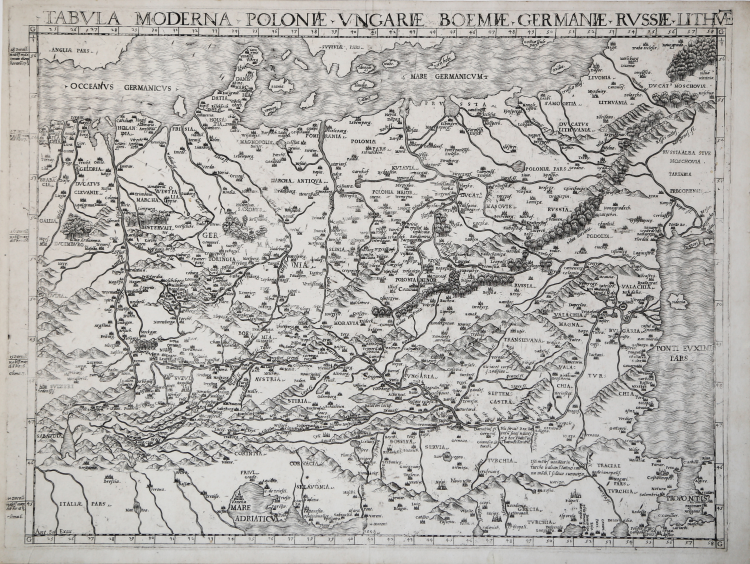




| Reference: | S43050 |
| Author | Antonio SALAMANCA |
| Year: | 1548 |
| Zone: | Central & Eastern Europe |
| Measures: | 525 x 400 mm |



| Reference: | S43050 |
| Author | Antonio SALAMANCA |
| Year: | 1548 |
| Zone: | Central & Eastern Europe |
| Measures: | 525 x 400 mm |
Very rare and early version of the map of Nicholas Cusanus, printed in Rome by Antonio Salamanca in 1548.
Niccolò da Cusa, known as Niccolò Cusano (ted. Nikolaus Chrypffs or Krebs von Cues) is the author of a map of Central and Eastern Europe, printed in Eichstätt in 1491. Cusano's work influenced all Italian cartographic production in the 16th century. Its first real printed derivation is represented by the plate included in the 1507 Roman edition Geographia, edited by Marco Beneventano, while the first "loose" map of the region is due to Giovanni Andrea Vavassore, and can be dated to the third decade of the century.
At the top, outside the graduated margin, is engraved the title: TABULA MODERNA POLONIAE UNGARIAE BOEMIAE GERMANIAE RUSSIAE LITHU[ANI]AE. In the lower left corner we find the editorial imprint: Ant. Sal. Excu. In the center of the paper, along the lower edge and to the right of the Adriatic Sea, is the imprint date: 1548. On the left side, outside the graduated margin, the division into climates and day length at different latitudes. Map lacks orientation and graphic scale. Graduation in the margins of 10' in 10', from 44° 10' to 56° 30' latitude and from 24° to 58° longitude.
Etching and engraving, impressed on contemporary laid paper with watermark "scale in circle with star" (Woodward nos. 238-242, which is found on maps dated or datable between 1540 and 1561) with margins, in excellent condition. Example in the first state of two.
“La carta dell’Europa centrale edita dalla tipografia di Antonio Salamanca è basata sul modello di Niccolò Cusano. Si tratta, più verosimilmente, di una derivazione della mappa di Marco Beneventano Tabula Moderna Polonie Ungarie Boemie Germanie Russie Lithuanie edita sempre a Roma nel 1507 ed inserita nella Geographia di Tolomeo. Tuttavia, la carta del Salamanca mostra una migliore e più dettagliata descrizione dell’Europa orientale. Nella carta le informazioni sulla Polonia fornite da Bernhard Wapowski, già inserite nella carta del Beneventano si associano ai dati desunti dalla mappa della Sarmazia dello stesso Wapowski (1526). Il secondo stato della carta, privo dell’indirizzo di Salamanca, è conservato a Leida. Sebbene privo di dati editoriali, può essere ricondotto alla tipografia di Antonio Lafreri e datato dopo il 1562, anno della scomparsa del Salamanca e poco prima della fine del sodalizio tra i due editori” (cfr. S. Bifolco – F. Ronca, Cartografia e topografia italiana del XVI secolo (2018), p. 886.
Antonio Salamanca, from Milan, settled in Rome before the Sack of 1527, living in the Parione district. Printer, publisher, merchant and also engraver. In his production we find numerous prints taken from paintings and drawings by Michelangelo and Raphael. Salamanca was always updating his catalog and printing what the market at the time demanded. He also had the merit of having researched, not only for commercial purposes, the plates dispersed during the Sack of Rome, and of having those that had deteriorated retouched, thus saving important works of the Italian chalcographic tradition. Strong competition in the chalcographic and publishing field at that time led Salamanca, in 1553, to associate with Antonio Lafreri, a young and enterprising competitor who had been in Rome since 1544. In the society, the driving force was Lafreri, in fact after 1553 few prints under his name are known of Salamanca. Salamanca died in 1562 and, he was succeeded in the society by his son Francesco, but for reasons unknown to us the society dissolved after only one year. Francesco Salamanca later sold all the plates to Lafreri.
Bibliografia
S. Bifolco – F. Ronca, Cartografia e topografia italiana del XVI secolo (2018): pp. 886-887, tav. 322, I/II; Borroni Salvadori (1980): n. 69; Banfi (1947a): n. 5; Herrmann (1940): n. 7, tav. 12b; Karrow (1993): n. 23/1.8; Meurer (1983): n. 1b; Meurer (2001): p. 118, n. 1.4.2.a-b; Műller (1897): n. 14; Niewodmiczański (2002): vol. II, p. 19, n. K2/2; Száantai (1996): p. 707; Szathmáry (1987): n. 37; Tooley (1939): n. 248; Witcombe (2008): p. 105, n. 131.
Antonio SALAMANCA (Milano ?, 1478 – Roma, 1562)
|
Print publisher and dealer in books and prints from Salamanca. Active in Rome. His family name was Martinez. He was in Rome by 1505. From 1517 till his death he was active as a publisher and book and print seller; also as a banker. His shop was in Campo dè Fiori and was recorded as a place where learned antiquarian conversations took place. Many of the prints he published were of Roman antiquities, starting in 1538 with prints such as the Colosseum engraved by Fagiuolo after Giuntalodi. In 1553 he formed a partnership with Antonio Lafreri, which was dissolved only after his death by his son Francesco.
|
Antonio SALAMANCA (Milano ?, 1478 – Roma, 1562)
|
Print publisher and dealer in books and prints from Salamanca. Active in Rome. His family name was Martinez. He was in Rome by 1505. From 1517 till his death he was active as a publisher and book and print seller; also as a banker. His shop was in Campo dè Fiori and was recorded as a place where learned antiquarian conversations took place. Many of the prints he published were of Roman antiquities, starting in 1538 with prints such as the Colosseum engraved by Fagiuolo after Giuntalodi. In 1553 he formed a partnership with Antonio Lafreri, which was dissolved only after his death by his son Francesco.
|